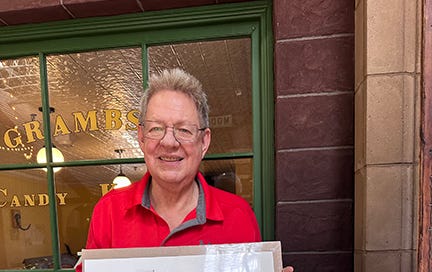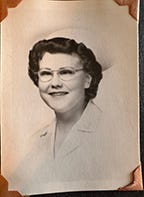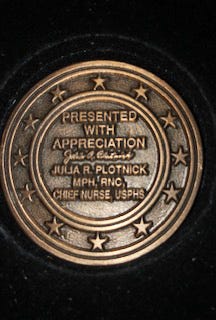From Train Whistles to Stethoscopes: The Depot Agent’s Daughter
This week, two commemorative days reminded me of the story I thought I would tell—and the one I ultimately wrote. My mom, Janette, was a public health nurse and the daughter of a depot agent.
Join me as I post stories behind the manuscript and bring the manuscript to a published book. Currently, my manuscript is still in proofreading, deciding on photographs and book cover design phase.
Two important dates slipped by this past week: National Nurses Day and National Train Day. Both are part of Janette Minehart's story—though in quieter, more personal ways than I once expected.
For about a year, I had been waiting to write posts to send you on National Nurses Day and National Train Day.
National Nurse’s Day was May 6, 2025
Janette Minehart’s graduation photo from Hamline-Asbury School of Nursing, 1951 (from Janette’s scrapbook)
Janette’s dad, Russell, worked as a depot agent and telegrapher. She loved the sound of trains so much that, as an adult, she owned a vinyl record filled with whistles and the rhythmic clickety-clack of passing engines.
I kept that record after she died.
When I first wrote her story, I joined Facebook groups of train fanatics and researched nursing publications. But as important as both nursing and trains were to Janette, I don't think I can market this book as a train or a nursing story.
Janette wasn't just any nurse. She was a public health nurse.
After becoming an RN, she said it took her a few years to work up the courage to attend the University of Minnesota for her bachelor's in public health. In those days, not many women had a bachelor’s degree. The two traditional professions for women often didn’t require a college degree. (Nurses often had a diploma, and teachers attended a “normal” or “training” school.)
She was proud of her degree and profession, though when it was my turn to pick a profession, she warned me not to go into nursing: "You won't make any more money than a retail store clerk," she said. That may have been true at the time—but by the time I graduated from college, nurses started getting decent pay.
When I was a child, she worked with migrant families in the Red River Valley. Many lived in small farmyard shacks without running water. Can you imagine caring for a baby with no running water?
When I was in preschool, she visited mothers hoeing weeds in sugar beet fields—because their young children were often right there beside them. Sometimes, she took me along, and I played with the kids. That's where I first learned the Spanish pronunciation of my name—Noemí—which sounded like "No Amy."
Above is a photo of the medal (front and back) Janette received when she retired. The United States has had a Public Health Service since 1798. The nation’s first public health agency, the Marine Hospital Service (MHS), was formed to care for sick and injured seamen. Learn more here.
Later, she worked as director of Public Health Nursing for the Indian Health Service on the Standing Rock Sioux Indian Reservation. Her specialty was maternal and child health.
While living in Florida, where she thought she would retire, she worked as a hospital nurse in her early 50s. One evening, she watched a horrific child abuse story on the TV news in which a parent who had lost her patience killed a child out of frustration and exasperation. Janette said to herself, I have to get back to public health nursing. "I read that one visit from a public health nurse could prevent child abuse," she told me.
In her specialty of maternal and child health, she taught new parents what to expect. These include things like developmental milestones, feeding, language development, physical development, handling the “terrible twos,” getting a toddler to bed and other behavioral issues. That tragic TV news story spurred her to search for jobs in public health nursing. She applied to be a public health nurse with the Indian Health Service at Standing Rock.
Because it was National Train Day this past Saturday, I visited the Lake Superior Railroad Duluth Museum. Real train whistles permeated the inside and outside of the area, which smelled like rope and oil. The place was packed with tourists and train fans. Vendors had displays pertaining to transportation, history and safety.
Model train builders had a whole room to themselves.
I toured passenger cars, mail cars, a display on porter uniforms and displays of different branded china because meals and eating on the diner car used to be quite the experience.
Outside the museum, a real train waiting for tourists took them up the North Shore of Lake Superior.
John Cartwright holds his sketch of the Slatyon, Minn. depot. “Railroads have always held a special fascination for me,” Cartwright said, “As nearly all of the previous generations of my family depended on it for their livelihood.” (Photo by Naomi)
I met an artist who had sketched nearly every depot in Minnesota based on photographs he'd taken while traveling with his father. I asked him if he had a photo of the Worthington Depot because that is where the Minehart family departed and arrived since no passenger trains stopped in Avoca. He told me that a passenger train had, indeed, stopped in Avoca until the 1950s. Well, that’s not what my Mom told me, I thought to myself. He said that the passenger train only stopped at Avoca once a week and made a lot of pit stops. Also, passengers had to board another train to get to Sioux Falls. I decided he knew much more about trains than I did, and it was quite possible that when Winifred and Russell put their five children on the train to visit South Dakota relatives, they didn’t want the children to have to transfer.
I also met someone from the James J. Hill House in St. Paul. She gave me a lesson in physics on how train wheels work.
National Train Day is observed on the Saturday closest to May 9—the anniversary of the Central Pacific and Union Pacific railroads meeting at Promontory Summit, Utah. That historic moment in 1869 was marked with the ceremonial driving of a golden spike, completing the first transcontinental railroad.
This “Golden Spike” was one of the treats offered for sale. It is chocolate and commemorates the golden spike drive in Promontory Summit, Utah, resulting in a transcontinental railroad.
Originally, I set out to write a book about Janette's nursing career. But when I tried to interview her about her career, she clammed up. What she really wanted was a story about her childhood.
So that's the story I wrote. But, the trains and the nursing are NOT the biggest bells and whistles; they are more of a backdrop in the scenes that tell the stories. They are stories of joy during hard times.









Here is a comment from Alice,
Dear Naomi,
I particularly enjoyed your substack. At the end of WWII my parents and I returned to Cheyenne,
Wyoming from Corpus Christi, Texas, where my dad was stationed in the Navy. The Union Pacific Railroad was hiring the returning men for railroad related jobs. My dad had one semester of college to finish, but he felt it would be wrong to return to college when he had a wife, a child and one on the way.. He grabbed a job as a carman, one who worked on trains with problem in the yard. That was his career until he retired,
Another enticement of the railroad was to offer housing in a huge complex. We rented an apartment - there were four units strung together facing another four units with an alley between
this alley turned and there were four more units which faced a large grassy field, The alley curved again and there were two more units of face facing another four. This pattern was repeated for acres,This is called a low-ncome housing today and is the only one out of three post-war (railroad) housing that still exists. These units were build of concrete - inside and out though walls were covered inside with sheet rock. My mom’s feet swelled on the concrete floors
and she grew weary of wives (with no college education) who gathered to drink coffee (with a little alcohol) and gossip. She had been a teacher until married teachers were not allowed to teach and she was bored. A school was built for the railroaders kids: the workers included a
large number of migrant workers who had lived in Mexico. Because the railroad offered a better
salary, the Mexican migrants became railroad workers. They did not live in VanTassell as our
housing project but in houses they bought or rented south of the school. At least every class was half Mexican (correct term because Mexico was their previous home) and Anglo kids.
There were so many kids in Van Tassell with all the war babies that all one had to do was go
outside and their were plenty of playmates. My mom worked as a school volunteer and wound up
as PTA President. Then a call came out for teachers - the married ban was broken. My mom went to work as a substitute and was hired for a full-time kindergarten teacher. She had only a two year degree from a well-known teachers College in Colorado, which had enabled her to
teach prior to mariage. Now four years were required so she had to prove each year she was working on correspondence and summer school credits. She graduated from the college the same year I graduated from college and was involved in the school district until a few months before her death at almost 96. My dad continued to work for the UP until he was 65.
When I was entering fifth grade, my parents achieved the dream of buying their own home. My dad did not like to have a working wife, but her salary made it possible to buy a home. This home was on “the other side of the tracks”quite literally because our house was a half-block from the C and N Railroad. Both sets of track divided Cheyenne into the poor and more advantaged parts of Cheyenne. We had arrived but we had trains almost in our backyard.. We didn’t care - my dad had taught us the joy of trains. If my mom awakened at night and heard a train she said “I knew all was right with the world.: Once our older son , as a preschooler, got to ride in the engine of a train - my dad made friends with all the engineers. He also was responsible for a marks being put on our garage by the “Hoboes” who road the trains. Dad always would fix each one who stopped
a sandwich.
I loved learning more about your mother's career as a public health nurse.